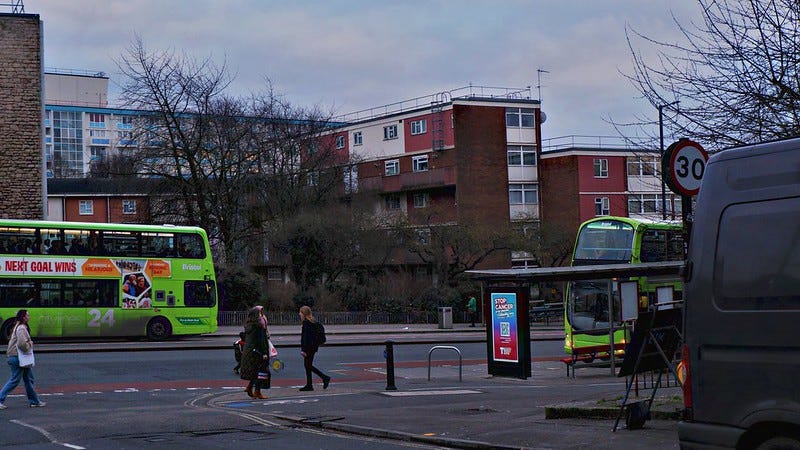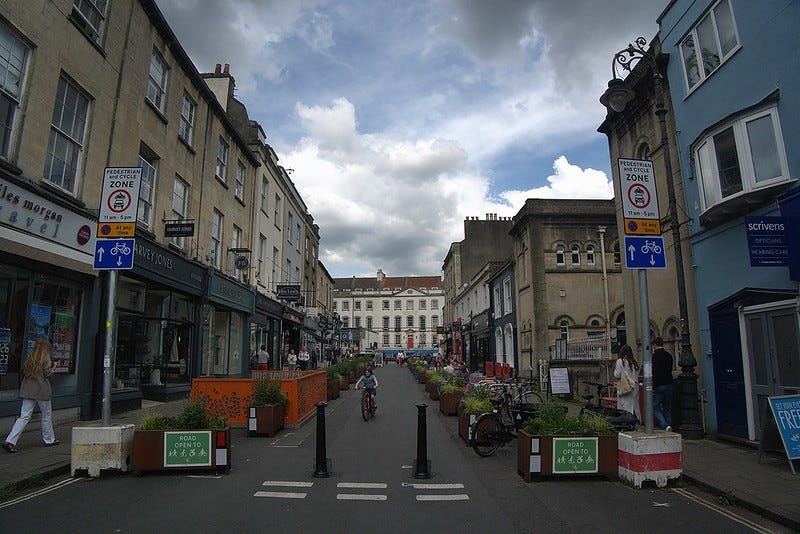The Horseless Cart of Urban Transportation
Clean air is a big topic in the world of 21st century transportation. In 2023, London’s expansion of its Clean Air Zone (CAZ) sparked a national controversy, with opposition being fronted by the bold (to put it mildly) “Blade Runners” taking action by sabotaging and even attempting to remove the Automatic Number Plate Recognition (ANPR) cameras used to enforce the scheme. Their latest strategy has been to put up bat boxes in front of the cameras, not only rendering them useless, but preventing any remedial work being done, as any structure used by bats as habitat is legally protected in the UK. Closer to home for me, Bristol and Bath have both introduced clean air zones amid a fair amount of local controversy. Low Traffic Neighbourhoods (LTNs) have been another attempt to reduce car traffic, again, not without stiff controversy.
Personally, I am quite fine with reducing car traffic volumes, more because of the improvements to the reduction of visual and noise pollution that come with high private transport usage, but I do have a serious concern as to how it’s being done. Traffic calming measures are easy to implement; good public transport service, less so, but all the more important. Make it as hard as you will to drive, but people will still get into their cars if they do not perceive public transport to meet their travel needs.

Here in the UK, we’re blessed to have a pretty decent public transport system — most places are served by buses if not by trains, even if they’re slow and not always reliable. Contrast that to what I grew up with in South Africa — nothing! Those unable to drive, myself included, have to rely on lifts when some kind soul is available to provide, or pay the high cost of a taxi, or sit at home and stare at the same four walls. That said, even the UK has a reputation for an unreliable public transport system in which it is not uncommon to hear of trains canceled or delayed, or buses showing up late or not at all. I will still count my blessings to live in a country in which I can walk out of my front door and go pretty much wherever I want without relying on a lift or a taxi, but I am also fortunate to live with a retired family member who does drive, and we not infrequently choose to do so over using the bus or train, simply because of the time saving. We’re quite close to Bristol city centre and Temple Meads railway station, but when it’s a difference between a ten minute car ride into town versus roughly if not more than half an hour by bus, i.e., the difference between a trip taking half a morning or afternoon versus the entire morning or afternoon, it is hard to argue with the convenience and time saving of the car.
I say all this to highlight that while we should absolutely celebrate the great public transport systems we have in the UK and in many other countries, simply having a public transport system is not enough to encourage the genuine modal shift that so many want to see occurring — people will only make the switch if they believe they have a convenient and reliable public transit service that will compare favourably in terms of time, cost, and convenience to their private vehicles.
There is no denying that traffic calming and reduction schemes can play a huge role in helping achieve this when running a public transport service comparable for cost and convenience is more challenging, but is it really right and fair to discourage private transport without ensuring that the travelling public have a service they believe they can rely on to get them to their destinations in reasonable cost an comfort? I don’t believe so, but it seems like some folks in the mechanisms of the state haven’t the same view. For all the talk of improving service levels on a national scale, we seldom see concrete promises to achieve service improvements, let alone results.

The challenges in the UK is not to be underestimated. Public transit and active travel can never fully cover all those journeys that need to be made into and within urban areas, and with such limited space as we have on our historic urban road networks, it’s not that easy installing the necessary infrastructure to allow buses to travel freely without getting stuck in traffic, or cyclists to traverse the town or city without fear of unwary or careless drivers taking chances and putting cyclists in danger. And no amount of extra funding will solve a reliability problem when buses are liable to get held up in traffic, neither will portions of protected cycling lanes do much to encourage people to bike when there are substantial gaps which they must span at risk to life and limb.
It is no use pretending that there is anything like a one-size-fits-all formula for allocating space on historic street networks, but the UK is not the only county to face these challenges, neither have we no history of our own to draw ideas from. What is necessary is to take a long-term strategy, rolling out traffic calming and reduction measures as public transport service improvements are introduced. Perhaps these cannot be done simultaneously, but just having a plan can go a long way to helping convince the public the the pain of the transition will be worth the tangible gain once complete.
Arguably the most effective approach to solving our transportation woes is the construction of new, dedicated rights of way, ideally some form of tramway, light railway, or metro. That, however, takes money, and would likely involve evicting people from homes and businesses from premises, which, in cities which do not have an existing segregated public transport network, is not going to go down well. Another approach, suggested by the advocacy group, Bath & Bristol Trams, involves building single track tramways on narrow streets, with passing loops where space permits to allow trams to pass. They suggest this approach particularly for city centre and inner city streets, but I would also venture the thought that even on suburban trunk roads too narrow for double track segregated right of way, a little creativity could potentially replace alternate direction bus lanes with a single tramway alternating with traffic light controlled single traffic lanes to allow for passing loops and stops. Perhaps I have more vision than professional knowledge, but solutions have to start somewhere, even if they require adaptation or refinement.
The great thing about a ram or light rail system is its relative flexibility, running along streets where space permits, or striking onto fully separate rights of way when necessary to allow sufficient road space for some traffic flow. However, as transit advocate Reece Martin is often wont to remind his followers on his YouTube channel RMTransit, no single pubic transit mode is the ideal solution for every transport requirement. Light rail may combine the flexibility of a bus with the energy efficiency of a train, but its capacity and speed are limited, so it’s really only a more efficient alternative to a bus, but that’s all that’s required for many UK towns and smaller cities.
With a radial tram network in place, this could hopefully encourage more people to travel by public transportation, which would also improve the viability of running orbital bus services connecting different suburban and out-of-town hubs, which is another vital link in the chain driving the desired modal shift. It goes without saying that not all journeys are radial in direction, and orbital journeys are among the most commonly travelled by private transport as the time difference is often much greater than radial journeys, while suburban or out-of-town hubs more typically have much more parking space, which is often more difficult to obtain in urban centres. It could of course be argued that mid-20th century style car-centric urban planning should be unheard of by now, but even if we don’t plan towns and cities that way (as unfortunately, we still do), the existing car-centric hubs aren’t going away any time soon. I don’t personally think this is a bad thing — with proper planning, such hubs can help spread out economic activity, offering more choice to people, and improving the justification for better public transport service, both radial and orbital, and this can also benefit trips that otherwise have little or nothing to do with those hubs themselves, such as trips to visit family and friends, or service businesses operating in people’s homes.
<a href="https://medium.com/media/062c31107ab640e9166b2125b9bfcc7e/href">https://medium.com/media/062c31107ab640e9166b2125b9bfcc7e/href</a>
Encouraging a modal shift is not just about halting ostensibly man-made climate change — you do not even need to believe that human emissions are causing a global catastrophe to recognise the environmental benefits even in the shot term. I say so because that’s where I stand — I have my scepticism for the humanity-induced climate change narrative, but I would till contend that there are benefits to us cutting down on polluting forms of transportation. But I remain adamantly of the view that total prevention of car use, whether through pricing people out or making it almost impossibly to make necessary journeys by car or van is unfair and unwise. But we should not have to do that to encourage people to exchange the car or van for the bike, bus, or train. By adopting a long-term strategy that responds directly to the current and anticipated future needs of the travelling public, we can strive to make public transport and active travel so good that people actually want to use it.


